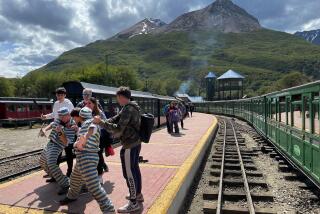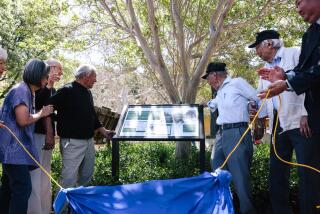Readers React: Manzanar’s brutal isolation conveys the cruelty of Japanese internment
To the editor: As I read David L. Ulin’s piece about his recent visit to Manzanar in the Owens Valley, I could not help but wonder if we had visited the same place. My teenage daughters and I did not need a fully recreated camp to understand the injustice done to Japanese Americans there during World War II.
Row upon row of internee barracks’ foundations serve as a stark reminder of the xenophobia that laid them. Fully reconstructed buildings are not required; a little imagination is.
Walking around Manzanar reinforces its isolation — there is almost nothing in sight but mountains and desert scrub — and the brutality of its climate. And the wind — the unceasing wind.
It does not take a particularly creative mind to imagine the inhumanity of the camp. Manzanar’s minimalism forces the visitor to do just that.
David Eaton, Rancho Palos Verdes
..
To the editor: Apparently, Ulin prefers history visualized in brick and mortar as a kind of Disneyland of “shame.” As for Manzanar, Ulin did not describe the fine interpretive exhibitions or historical movie.
I have attended both with friends who lost family members in Europe during the Holocaust. Their reactions were profound and personal. While they did not describe Manzanar as a “concentration camp,” it clearly represents the first step toward that unthinkable evil.
As an archaeologist and former member of the National Park System Advisory Board’s National Landmarks Committee, I was privileged to participate in the review process for Heart Mountain Relocation Center in Wyoming and the Central Utah Relocation Center, where together nearly 19,000 Japanese Americans were interred.
The human experience of these sites, and of Manzanar, is presented within each desolate, windswept landscape. A poem written by a Heart Mountain internee was read during the National Landmark status presentation for that site. It speaks louder than any reconstructed building:
“Snow upon the rooftop/ Snow upon the coal/ Winter in Wyoming/ Winter in my soul.”
Jo Anne Van Tilburg, Los Angeles
The writer is an associate researcher at the UCLA Cotsen Institute of Archaeology.
..
To the editor: President Franklin D. Roosevelt acted not out of xenophobia toward Japanese Americans, but rather his intent to protect citizens after a horrendous act of war perpetrated by the Empire of Japan.
It is fairly easy, 73 years after the resolution of the conflict, to Monday-morning quarterback his actions, but I don’t remember many who thought his response to keep us safe was worthy of shame.
Having lost a number of family members in that colossal conflict, I have felt a tremendous number of emotions, but shame is not one of them.
William David Stone, Beverly Hills
..
To the editor: During a family vacation more than 40 years ago, my father pulled our car to the side of the road along that deserted stretch of highway bordering Manzanar. I don’t believe there was much at all to see, but my father knew what was there.
As we stood looking toward the remains of the camp, he told me a childhood story about his Japanese neighbors and a young friend who suddenly had to leave. He guessed that the family ended up in Manzanar and described what the camp was.
My father didn’t have to say anything about how terrible this was; I understood it in his voice and in the story that stayed with him for decades. The memory of him on the road next to Manzanar stays with me still.
Jeff Francisco, Riverside
Follow the Opinion section on Twitter @latimesopinion and Facebook
More to Read
A cure for the common opinion
Get thought-provoking perspectives with our weekly newsletter.
You may occasionally receive promotional content from the Los Angeles Times.










